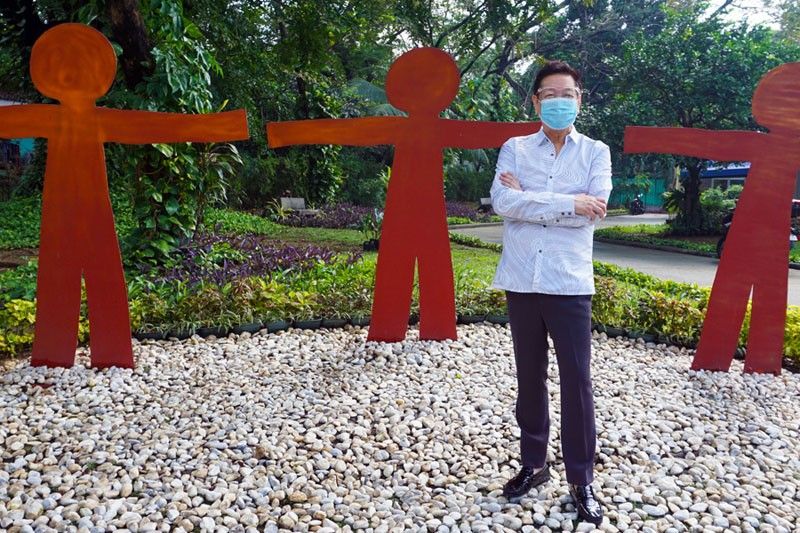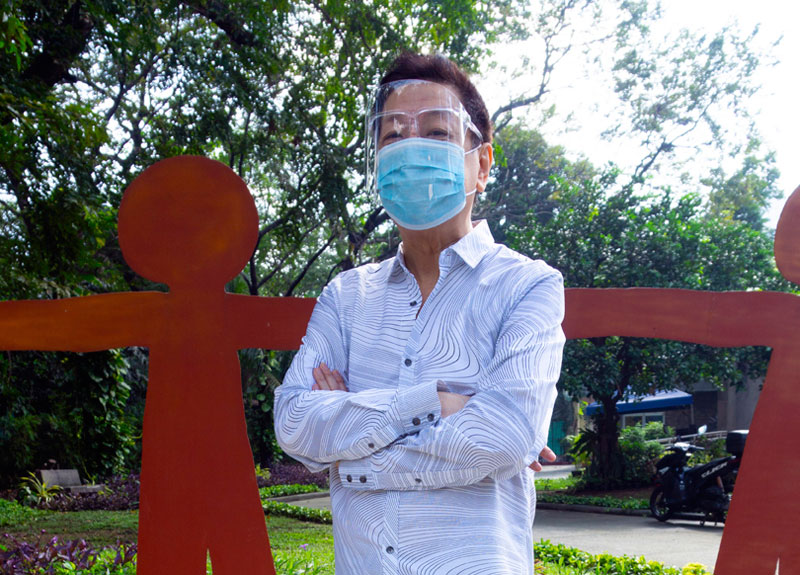Rachy Cuna: The art of healing

If artists have the power to heal the world in the time of the pandemic, multi-faceted artist Rachy Cuna is a conduit of healing.
In solidarity with frontliners, Rachy recently turned over his art installation titled “Tribute to the Frontliners of the World” to the National Museum of the Philippines (NMP). The artwork is now displayed on the grounds of the National Planetarium, which is owned and managed by the NMP.
“The health workers at the front lines around the world are our heroes. They help us fight the virus. And they do it with all selflessness. Many of them have died in the battle. Many doctors, nurses and other health practitioners are still fighting this unseen war so we all can be safe and healthy. And to them, I dedicate my artwork,” Rachy told me in a phone interview.
Truth is, Rachy’s triptych recast of oversized pieces of human figures — 192 cms tall and made of flat steel and painted in red-orange — was a resident of the National Museum for 10 years. The installation, originally titled “Kapit-Bisig,” was part of Rachy’s “Drama Cuna” exhibition in 2010 at the NMP and was eventually displayed at the courtyard of the National Museum of Fine Arts. In 2012, he donated the triptych to the NMP and it has since become part of the National Fine Arts collection but had to be conserved.
“His ‘Tribute to the Frontliners of the World’ is his gift to the nation. His installation is now at the National Planetarium as a visible reminder to passersby that we can overcome COVID-19 through cooperation and acknowledging the frontliners’ dedication by following health protocols,” says Ana Labrador, deputy director-general of the National Museum of the Philippines.
Rachy says, “Now more than ever, is the time to give inspiration to the frontliners for all that they do. I hope that with my artwork, I am able to bring positivity in the middle of these challenging times.” Because everything he does takes its own form, its own flair, its own meaning, Rachy thought of recasting his installation art “Kapit-Bisig” and giving it a new title, “Alay sa mga Tagapaghatid ng Pangunahing Tulong sa Buong Daigdig (Tribute to the Frontliners of the World).”

Ana says the NMP closed its facilities on March 13 due to the pandemic. “Rachy’s gesture this time is to send his message of inspiration, especially to the frontliners around the world who are dedicating their lives in leading the battle against the current health crisis. Entrusting his artwork to the NMP, Rachy would like to ensure that his message of thanks is properly conveyed to those whose sacrifices continue throughout the world.”
Rachy, who is known for his artistry in making meaningful art pieces from “found objects,” is the style director of Manila Hotel.
Ana adds, “Rachy is a creative consultant by profession and an artist by passion. His creations convey his personal, real and honest artistry without motivations of profit. Using ordinary things around him, he creates art that expresses his thoughts and feelings. Asked if being an artist is an inborn thing or a learned skill, he replied, ‘It is about being crazy — thinking out of the box.’”
***
Rachy is known as the country’s one and only floral architect.
He is known for his artworks that tickle flights of fancy. To witness his work is to enter a field of dreams. A bon vivant, he has the proclivity for telling beautiful stories through his artistry. He always proves that he is an endearing raconteur of his own drama and dreams.
His proclivity for making art out of objects he finds everywhere is at once amazing and inspiring. He calls them “found objects” because “I find them in the market, in hardware stores, on the road, in my garden, in my friend’s garden, in the forest, on the beach.” He is in constant exploration of how to better present his ideas and more often than not, his genius is tickled by everyday happenstance.
I joined him once in one of his trips to a palengke in Quezon province and witnessed how his mind works. In the market he found bulks of bakya (wooden clogs). Amazed at his “discovery,” his creativity ran wild instantaneously. He bought dozens and dozens of pairs of the wooden clogs and colored them shocking pink. Those wooden clogs had been turned into an installation titled “…Mo Neneng,” proving that the lowly bakya could be held in high esteem in the heart and mind of the artist.
Rachy loves to call his creations “unadulterated art” probably because he finds pure essence in every material he sees. In a hardware store, for instance, what others see as rolls and rolls of thin wires (kawad), Rachy sees as cutting-edge flower vases.
The same inspiration materialized when he laid his eyes upon sheets of flat steel — the cold metal was given warmth with life and heart as he fashioned from it images of people with hands stretched, ready to celebrate their individuality, ready to be together, in solidarity.
Those steel images now form part of the artwork “Tribute to the Frontliners of the World.” The message of Rachy Cuna’s triptych is loud and clear: support and solidarity, resilience and restitution and, above all, love and hope.
Tribute to the Frontliners of the World, a triptych installation art in flat steel by multi-faceted artist Rachy Cuna (inset), on the grounds of the National Planetarium in Manila.
(E-mail me at [email protected]. I’m also on Twitter @bum_tenorio and Instagram @bumtenorio. Have a blessed weekend.)
- Latest




























